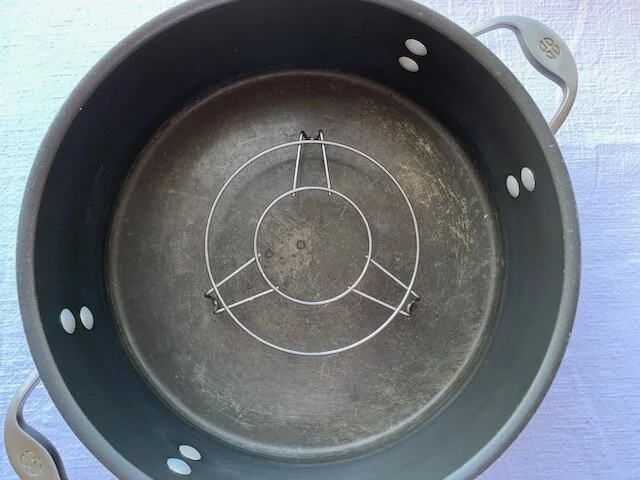Getting Started with Steaming
In Western cooking, steaming is most often used to cook vegetables—it is rarely used to cook meat. With Chinese cuisine, vegetables are usually stir-fried, and seafood and meat dishes are steamed. Sturdier vegetables like eggplant, squash and cucumbers can be steamed, but the more delicate vegetables are quickly cooked in the high heat of the stir-fry technique to preserve its nutrients, texture, and flavor. The steamed dishes commonly made in Chinese cooking include fish, pork spareribs, chicken, tofu, and egg.
To get started with steaming, you need a few relatively inexpensive items. Although there is a wide variety of specialty tools and appliances for steam cooking on the market, I recommend keeping it simple to start. In fact, you may never need to go beyond the basics. Even as a seasoned cook, I haven’t invested beyond this basic list of equipment.
The four things you need are:
Steaming Vessel with Domed Lid
Steam Rack
Wide Shallow Bowl
Plate/Bowl Grippers
1. Steaming Vessel with Domed Lid
You can use a wok, or a large, wide pot. This pot needs to be able to hold a dish on top of a steam rack, with at least an inch of clearance between the edge of the plate and the steaming vessel.
A domed lid is preferred as it keeps the water that condenses from the steam vapor from dripping on the food. This is not critical and you can work around a flat lid by wrapping it in a towel. You can also cover the food to prevent water from dripping on it.
I use a large wide pot that has a slightly domed lid, in addition to my wok. For some meals if I’m doing both steamed and stir-fried dishes, I like to have a separate vessel for steaming.
In general, I transform my pots and/or my wok into a steam vessel, but I’ve also tried a multi-tiered steam pot. There are many benefits to going this route as you can cook multiple dishes, or a large quantity simultaneously (ex. dumplings). It is also a great all-in-one cooking system for weeknight dinners (classes coming soon on this topic).
2. Steam Rack
This is what props the dish up inside of the steaming vessel and keeps the water from boiling over into the food. I look for stainless steel (vs. chrome) for long-term durability, and a height of about one inch. The height is an important consideration as it needs to elevate the dish above the water, while allowing the lid to fit tightly over the opening.
Options:
Traditional Steam Rack (this is what I use)
Multi-purpose Steam Rack. Steaming eggs is a great way to soft/hard cook them. If you don’t plan on doing this, go for the cheaper traditional one.
Inverted Shallow Bowl or Dish. You can also use this if it is the right height and size for your cooking vessel (see diagram above)
3. Shallow Wide Bowl
One of the best parts of steaming is the self-basting feature. When steamed, ingredients cook in their own juices and the resulting ‘sauce’ is delicious. As a child we would covet this sauce to pour over our rice: “Don’t take it all!”, we would say to others at the table.
In order to collect this sauce, a shallow, wide bowl is ideal.
4. Steam Plate Grippers
My grandma and mom never used these, but they were very skilled at picking hot dishes out of the steaming vessel with dish towels. The steam tongs are relatively inexpensive, and worth the investment. They make extraction of steamed dishes much easier and more reliable (nothing worse than dropping your steamed goodies into the hot water bath after all that effort!).
Options:
These are the grippers that I use, and they work well.
Here is an alternative that I haven’t tried myself, but it looks promising and is a bit cheaper.

